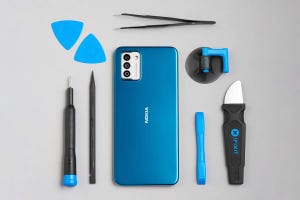
The Future of Phones Is DIY Repairability - CNET
Performing a highly technical demonstration in front of a live audience of journalists is always a risky move on the part of a technology company. You can almost guarantee that tech will fail you at the very moment you need it to perform at its best.
But not today, Satan. Today, Nokia Product Marketing Chief Adam Ferguson is replacing the battery on one of the company’s three new budget phones live on camera, all while providing onlooking press with a running commentary of exactly what he’s doing and why it’s so important.
Ferguson promises it’ll take him less than five minutes to complete the battery transplant, and though we can quibble over a few seconds either way, he fundamentally proves to be a man of his word.
“If someone like me — who isn’t particularly good with his hands, as you’ve probably seen from some of my shaky handling there — can do it while speaking to all of you, hopefully it demonstrates that absolutely anybody can,” he told us during the demo, which took place virtually, in the week preceding Mobile World Congress.
The Nokia G22, now waking up from major surgery performed by an amateur in front of our eyes, is designed with repairability at its very core. Thanks to a partnership with tech repair company iFixit, owners of this phone, announced at MWC in Barcelona on Saturday, will be equipped with guides and support to fix their phones themselves when the time comes. All they’ll need is a guitar pick and a #00 screwdriver.
It puts Nokia, which isn’t even in the top five global smartphone brands, ahead of the game this week at the world’s biggest mobile show, where sustainability is a major theme. In the context of the global climate crisis, the problem of electronic waste has become an increasingly pressing concern for tech companies and for consumers. Ensuring the products we use have a long life and aren’t easily disposed of as soon as our battery starts to flop is a key step in reducing the environmental impact of our tech use.
“We’re seeing already that people are holding on to their phones for longer,” Steven Moore said in an interview during the lead-up to Mobile World Congress. Moore is head of climate action at mobile industry body GSMA, which hosts MWC. He said the average lifespan of a smartphone has already stretched from two to three years. Plus, he added, people are showing more interest in repairing their phones, and are open to purchasing refurbished models in the first place.
Nokia isn’t the first to do this. Since 2013, Fairphone, a Dutch social enterprise, has been focused on trying to make modular phones that have a smaller environmental footprint. Since last April, Apple has also been supporting people who want to take care of DIY fixes on their iPhones, through its Self Service Repair program.
But the difference right now is that DIY repairs are beginning to shift from being a niche perk to being an important headline feature of new phones. “As consumers increasingly demand more sustainable and longer-lasting devices, the ability to repair smartphones easily and affordably will become a key differentiator in the market,” said Ben Wood, chief analyst at CCS Insight, in a statement.
Nokia might not be the pioneer of the repairability trend, but it’s adopting the practice at a key time. This year at MWC sustainability is front and center, as companies across the mobile landscape strive to reduce their environmental impact in line with the GSMA’s goal of the mobile industry reaching net zero carbon emissions by 2050.
Any phone manufacturers who don’t come to the show this year with a well-rehearsed set of arguments for why they aren’t taking control of repairability options for their devices should be prepared to face criticism, Emma Mohr-McClune, chief analyst and practice lead at analysis firm Global Data, said in a statement.
“At present, operators are staying out of this argument, but at one point even operators will start demanding more choice in this regard,” she added.
With pressure mounting from consumers and from other areas of the mobile industry, it’ll be up to phone manufacturers to respond by making it easier to replace device parts such as batteries and screens, which often bear the brunt of long-term use. But it’s important that they don’t neglect software as part of this conversation either.
When OnePlus released the OnePlus 11 earlier this month, it extended its support period for up to four years of Android updates and an additional fifth year of security updates. Without the promise of long-term security updates such as this, an otherwise decent phone can become unusable.
Good future-proofing also doesn’t lessen the responsibility on phone makers to ensure devices are already as sustainable as possible before they even reach your hands.
According to Moore, 80% of the environmental footprint of a mobile phone has already happened before you take it out the box. “That really means that we need to consider the actual embodied emissions and environmental impact within the device,” he said.
The long-term vision for future phones, as laid out in a GSMA strategy paper released last November, is that one day our devices will be 100% recycled and recyclable, as well as made with 100% renewable energy.
“There’s no device at the moment that fits that description, but we’re already seeing really promising signs from some of the manufacturers on this,” said Moore. “There’s a lot that the industry can do [and] I think we’re just at the beginning.”

